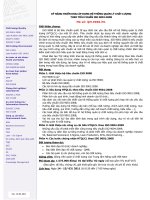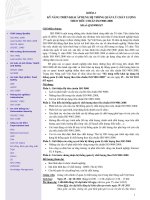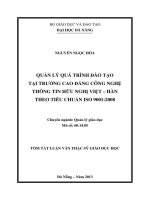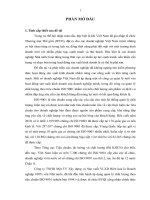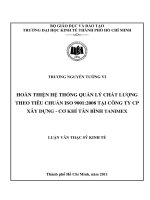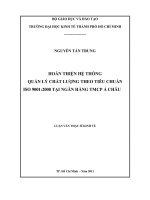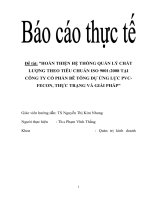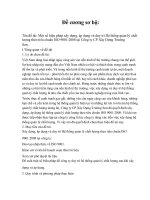Tiêu chuẩn tiêu chuẩn iso 15002 2008
Bạn đang xem bản rút gọn của tài liệu. Xem và tải ngay bản đầy đủ của tài liệu tại đây (259.02 KB, 28 trang )
INTERNATIONAL
STANDARD
ISO
15002
Second edition
2008-07-01
Flow-metering devices for connection to
terminal units of medical gas pipeline
systems
Dispositifs de mesure de débit pour raccordement aux prises murales
des systèmes de distribution de gaz médicaux
--`,,```,,,,````-`-`,,`,,`,`,,`---
Reference number
ISO 15002:2008(E)
Copyright International Organization for Standardization
Provided by IHS under license with ISO
No reproduction or networking permitted without license from IHS
© ISO 2008
Not for Resale
ISO 15002:2008(E)
PDF disclaimer
This PDF file may contain embedded typefaces. In accordance with Adobe's licensing policy, this file may be printed or viewed but
shall not be edited unless the typefaces which are embedded are licensed to and installed on the computer performing the editing. In
downloading this file, parties accept therein the responsibility of not infringing Adobe's licensing policy. The ISO Central Secretariat
accepts no liability in this area.
Adobe is a trademark of Adobe Systems Incorporated.
--`,,```,,,,````-`-`,,`,,`,`,,`---
Details of the software products used to create this PDF file can be found in the General Info relative to the file; the PDF-creation
parameters were optimized for printing. Every care has been taken to ensure that the file is suitable for use by ISO member bodies. In
the unlikely event that a problem relating to it is found, please inform the Central Secretariat at the address given below.
COPYRIGHT PROTECTED DOCUMENT
© ISO 2008
All rights reserved. Unless otherwise specified, no part of this publication may be reproduced or utilized in any form or by any means,
electronic or mechanical, including photocopying and microfilm, without permission in writing from either ISO at the address below or
ISO's member body in the country of the requester.
ISO copyright office
Case postale 56 • CH-1211 Geneva 20
Tel. + 41 22 749 01 11
Fax + 41 22 749 09 47
Web www.iso.org
Published in Switzerland
ii
Copyright International Organization for Standardization
Provided by IHS under license with ISO
No reproduction or networking permitted without license from IHS
© ISO 2008 – All rights reserved
Not for Resale
ISO 15002:2008(E)
Contents
Page
Foreword............................................................................................................................................................ iv
Introduction ........................................................................................................................................................ v
1
Scope ..................................................................................................................................................... 1
2
*Normative references.......................................................................................................................... 2
3
Terms and definitions........................................................................................................................... 2
4
Arrangement of flow-metering systems and devices ....................................................................... 4
5
5.1
5.2
5.3
5.4
5.5
General requirements........................................................................................................................... 4
Safety ..................................................................................................................................................... 4
Alternative construction ...................................................................................................................... 4
Materials ................................................................................................................................................ 4
Design requirements ............................................................................................................................ 5
Constructional requirements............................................................................................................. 10
6
6.1
6.2
6.3
6.4
Test methods....................................................................................................................................... 10
General................................................................................................................................................. 10
Test method for mechanical strength............................................................................................... 11
Test method for leakage .................................................................................................................... 11
Test method for durability of markings and colour coding............................................................ 12
7
7.1
7.2
7.3
Marking, colour coding and packaging ............................................................................................ 12
Marking ................................................................................................................................................ 12
Colour coding...................................................................................................................................... 13
Packaging ............................................................................................................................................ 13
8
Information to be supplied by the manufacturer............................................................................. 13
Annex A (informative) Rationale ..................................................................................................................... 15
Annex B (informative) Arrangements of flow-metering systems and devices .......................................... 17
Annex C (informative) Environmental aspects.............................................................................................. 20
Bibliography ..................................................................................................................................................... 21
--`,,```,,,,````-`-`,,`,,`,`,,`---
iii
© ISO 2008 – All rights reserved
Copyright International Organization for Standardization
Provided by IHS under license with ISO
No reproduction or networking permitted without license from IHS
Not for Resale
ISO 15002:2008(E)
Foreword
ISO (the International Organization for Standardization) is a worldwide federation of national standards bodies
(ISO member bodies). The work of preparing International Standards is normally carried out through ISO
technical committees. Each member body interested in a subject for which a technical committee has been
established has the right to be represented on that committee. International organizations, governmental and
non-governmental, in liaison with ISO, also take part in the work. ISO collaborates closely with the
International Electrotechnical Commission (IEC) on all matters of electrotechnical standardization.
International Standards are drafted in accordance with the rules given in the ISO/IEC Directives, Part 2.
The main task of technical committees is to prepare International Standards. Draft International Standards
adopted by the technical committees are circulated to the member bodies for voting. Publication as an
International Standard requires approval by at least 75 % of the member bodies casting a vote.
Attention is drawn to the possibility that some of the elements of this document may be the subject of patent
rights. ISO shall not be held responsible for identifying any or all such patent rights.
ISO 15002 was prepared by Technical Committee ISO/TC 121, Anaesthetic and respiratory equipment,
Subcommittee SC 6, Medical gas systems.
This second edition cancels and replaces the first edition (ISO 15002:2000) which has been technically
revised.
iv
Copyright International Organization for Standardization
Provided by IHS under license with ISO
No reproduction or networking permitted without license from IHS
--`,,```,,,,````-`-`,,`,,`,`,,`---
© ISO 2008 – All rights reserved
Not for Resale
ISO 15002:2008(E)
Introduction
Flow-metering devices are widely used for delivery of medical gases supplied by a medical gas supply system
directly to a patient. These devices need to deliver accurate flows under varying conditions of temperature and
inlet pressure. Therefore it is important that the operating characteristics be specified and tested in a defined
manner.
This International Standard pays particular attention to:
⎯
safety (mechanical strength, safe relief of excess pressure, resistance to ignition);
⎯
gas specificity;
⎯
cleanliness;
⎯
suitability of materials;
⎯
accuracy;
⎯
testing;
⎯
identification;
⎯
information supplied.
--`,,```,,,,````-`-`,,`,,`,`,,`---
Annex A contains rationale statements for some of the requirements of this International Standard. The
clauses and subclauses marked with an asterix (*) after their number have corresponding rationale contained
in informative Annex A, included to provide additional insight into the reasoning that led to the requirements
and recommendations that have been incorporated in this International Standard. It is considered that
knowledge of the reasons for the requirements will not only facilitate the proper application of this International
Standard, but will expedite any subsequent revisions.
v
© ISO 2008 – All rights reserved
Copyright International Organization for Standardization
Provided by IHS under license with ISO
No reproduction or networking permitted without license from IHS
Not for Resale
--`,,```,,,,````-`-`,,`,,`,`,,`---
Copyright International Organization for Standardization
Provided by IHS under license with ISO
No reproduction or networking permitted without license from IHS
Not for Resale
INTERNATIONAL STANDARD
ISO 15002:2008(E)
Flow-metering devices for connection to terminal units of
medical gas pipeline systems
1
Scope
1.1
This International Standard is applicable to:
⎯
flow-metering devices that are connected, either directly or by means of flexible connecting assemblies,
and disconnected by the operator at terminal units of a medical gas pipeline system for flow adjustment,
measurement and delivery of medical gases;
⎯
flow-metering devices that are connected and disconnected by the operator at gas-specific connection
points of devices such as pressure regulators.
1.2
This International Standard applies to:
a) flow-metering devices intended to be used with the following medical gases:
oxygen;
⎯
nitrous oxide;
⎯
medical air;
⎯
carbon dioxide;
⎯
oxygen/nitrous oxide mixture [50 %/50 % (by volume)];
⎯
specified mixtures of the gases listed above;
--`,,```,,,,````-`-`,,`,,`,`,,`---
⎯
b) flow-metering devices intended to be used with the following gases:
⎯
oxygen-enriched air;
⎯
helium;
⎯
xenon.
NOTE
Regional or national regulations might permit use of oxygen-specific connection points for oxygen-enriched air.
1.3
This International Standard does not apply to electrical or electronic flow-metering devices.
1.4
This International Standard does not apply to gases used for driving surgical tools.
1
© ISO 2008 – All rights reserved
Copyright International Organization for Standardization
Provided by IHS under license with ISO
No reproduction or networking permitted without license from IHS
Not for Resale
ISO 15002:2008(E)
2
*Normative references
The following referenced documents are indispensable for the application of this document. For dated
references, only the edition cited applies. For undated references, the latest edition of the referenced
document (including any amendments) applies.
ISO 32, Gas cylinders for medical use — Marking for identification of content
ISO 5359:2008, Low-pressure hose assemblies for use with medical gases
ISO 7396-1, Medical gas pipeline systems — Part 1: Pipeline systems for compressed medical gases and
vacuum
ISO 9170-1, Terminal units for medical gas pipeline systems — Part 1: Terminal units for use with
compressed medical gases and vacuum
ISO 11114-3:1997, Transportable gas cylinders — Compatibility of cylinder and valve materials with gas
contents — Part 3: Autogenous ignition test in oxygen atmosphere
ISO 14971:2007, Medical devices — Application of risk management to medical devices
ISO 15001:2003, Anaesthetic and respiratory equipment — Compatibility with oxygen
ISO 19054, Rail systems for supporting medical equipment
EN 837-1:1996, Pressure gauges — Part 1: Bourdon tube pressure gauges — Dimensions, metrology,
requirements and testing
EN 1089-3:2004, Transportable gas cylinders — Gas cylinder identification (excluding LPG) — Part 3: Colour
coding
EN 13544-2, Respiratory therapy equipment — Part 2: Tubing and connectors
3
Terms and definitions
For the purposes of this document, the following terms and definitions apply.
--`,,```,,,,````-`-`,,`,,`,`,,`---
3.1
diameter index safety system connectors
DISS connectors
any of a range of male and female components intended to maintain gas-specificity by allocation of a set of
different diameters to the mating connectors for each particular gas
3.2
flowgauge
device that measures pressure and is calibrated in units of flow
NOTE
The flowgauge does not measure flow. It indicates flow by measuring the pressure upstream of a fixed orifice.
3.3
flowmeter
device that measures and indicates the flow of a specific gas
3.4
flow-metering device
device fitted with an inlet connector and an outlet connector and which incorporates one of the following:
a)
a flowmeter with a flow control valve;
b)
a flowgauge and a fixed orifice with a flow control valve;
2
Copyright International Organization for Standardization
Provided by IHS under license with ISO
No reproduction or networking permitted without license from IHS
© ISO 2008 – All rights reserved
Not for Resale
ISO 15002:2008(E)
c)
one or more fixed orifices with a means of flow selection.
NOTE
Typical examples of flow-metering systems and devices are given in Figures B.1 and B.2.
3.5
gas-specific
having characteristics which prevent connections between different gas services
3.6
gas-specific connection point
that part of the socket which is the receptor for a gas-specific probe
3.7
hose insert
that portion of a connector which is pushed into and secured within the bore (lumen) of the hose
3.8
manufacturer
natural or legal person with responsibility for the design, manufacture, packaging and labelling of a device
before it is placed on the market under his or her own name, regardless of whether these operations are
carried out by that person or on his or her behalf by a third party
3.9
medical gas pipeline system
complete system which comprises a supply system, a monitoring and alarm system and a pipeline distribution
system with terminal units at the points where medical gases or vacuum may be required
3.10
medical gas supply system
either
a)
a medical gas pipeline system or
b)
an installation having no permanent pipeline system but employing a medical gas supply source complete
with pressure regulator(s)
3.11
non-interchangeable screw-threaded connector
NIST connector
range of male and female components intended to maintain gas specificity by the allocation of a set of
different diameters and a left- or right-hand screw thread to the mating components for each particular gas
3.12
probe
gas-specific male component designed for acceptance by and retention in the socket
3.13
rated inlet pressure
p1
maximum upstream pressure for which the flow-metering device is designed to operate
3.14
single fault condition
condition in which a single means for protection against a safety hazard in equipment is defective or a single
external abnormal condition is present
3.15
socket
female part of a terminal unit which is either integral or attached to the terminal unit base block by a
gas-specific interface and which contains the gas-specific connection point
--`,,```,,,,````-`-`,,`,,`,`,,`---
3
© ISO 2008 – All rights reserved
Copyright International Organization for Standardization
Provided by IHS under license with ISO
No reproduction or networking permitted without license from IHS
Not for Resale
ISO 15002:2008(E)
3.16
terminal unit
outlet assembly (inlet for vacuum) in a medical gas supply system at which the operator makes connections
and disconnections
4
Arrangement of flow-metering systems and devices
Typical examples of flow-metering systems are shown in Annex B.
5
General requirements
NOTE
Unless otherwise specified, pressures in this International Standard are expressed as gauge pressures
(i.e. atmospheric pressure is defined as 0).
5.1
Safety
Flow-metering devices shall, when transported, stored, installed, operated in normal use and maintained
according to the instructions of the manufacturer, present no risks that are not reduced to an acceptable level
using procedures in accordance with ISO 14971 and which are connected with their intended application, in
normal conditions and in single fault conditions.
5.2
Alternative construction
Flow-metering devices, and components or parts thereof, using materials or having forms of construction
different from those detailed in this clause (except for dimensions and allocation of DISS and NIST connectors
and probes used as inlet connectors), shall be presumed to be in compliance with the safety objectives of this
International Standard if it can be demonstrated that an equivalent degree of safety is obtained (i.e.
compliance with requirements presumes that risks have been mitigated to acceptable levels) unless objective
evidence to the contrary becomes available.
NOTE 1
Objective evidence might be obtained by postmarket surveillance.
Evidence of an equivalent degree of safety shall be provided by the manufacturer upon request.
NOTE 2
Regional or national regulations may require the provision of evidence to a competent authority or conformity
assessment body (e.g. notified body in the European Economic Area) upon request.
NOTE 3
Attention is drawn to ISO 14971 on risk management and to the International Standards under development
by ISO/TC 210.
5.3
Materials
5.3.1 *The materials in contact with the gases listed in 1.2, during normal use, shall be resistant to corrosion
and compatible with oxygen and the other gases and their mixtures in the temperature range specified in 5.3.3.
NOTE 1
Corrosion resistance includes resistance against moisture and surrounding materials.
NOTE 3
ISO 15001 contains information on selection of metallic and non-metallic materials and other aspects of
compatibility of equipment with oxygen.
4
Copyright International Organization for Standardization
Provided by IHS under license with ISO
No reproduction or networking permitted without license from IHS
© ISO 2008 – All rights reserved
Not for Resale
--`,,```,,,,````-`-`,,`,,`,`,,`---
NOTE 2
Compatibility with oxygen involves both combustibility and ease of ignition. Materials that burn in air burn
violently in pure oxygen. Many materials that do not burn in air will do so in pure oxygen, particularly under pressure.
Similarly, materials that can be ignited in air, require lower ignition energies in oxygen. Many such materials can be ignited
by friction at a valve seat or by adiabatic compression produced when oxygen at high pressure is rapidly introduced into a
system initially at low pressure.
ISO 15002:2008(E)
5.3.2 *For flow-metering devices for all gases, the autoignition temperature of the non-metallic components
in contact with the gas, including the sealing materials and lubricants (if used), shall be no lower than 160 °C.
Evidence of conformity with this requirement shall be provided by the manufacturer upon request.
NOTE 1
Regional or national regulations might require the provision of evidence to a competent authority or conformity
assessment body (e.g. notified body in the European Economic Area) upon request.
The determination of the autoignition temperature shall be carried out in accordance with ISO 11114-3.
NOTE 2
The maximum permitted operating temperature of tested material is 100 °C lower than the autoignition
temperature at the corresponding oxygen pressure. This safety margin is necessary because it covers both an unforeseen
increase in the operating temperature and the fact that the autoignition temperature is not a constant. Values of the
autoignition temperature always depend on the test method used, which does not exactly simulate all possible operating
conditions.
5.3.3 The materials shall permit the flow-metering device and its components to meet the requirements of
5.4 (except 5.4.6.3, 5.4.7.3 and 5.4.8.2) in the temperature range of −20 °C to +60 °C.
5.3.4 Flow-metering devices shall meet the requirements of 5.4 after being exposed, whilst packed for
transport and storage, to environmental conditions as specified by the manufacturer.
5.3.5 Springs, highly strained components and parts liable to wear which come in contact with the gas shall
not be plated.
NOTE
Plating could come off.
--`,,```,,,,````-`-`,,`,,`,`,,`---
5.3.6 Evidence of conformity with the requirements of 5.3.1 to 5.3.5 shall be provided by the manufacturer
upon request.
NOTE
Regional or national regulations might require the provision of evidence to a competent authority or conformity
assessment body (e.g. notified body in the European Economic Area) upon request.
5.4
Design requirements
5.4.1
5.4.1.1
Gas supply inlet
Inlet
The gas supply inlet shall be one of the following:
a)
a probe complying with ISO 9170-1 permanently attached to the flow-metering device [see Figure B.2 a)];
b)
a nut and nipple, either complying with DISS or NIST specifications in ISO 5359, or complying with an
equivalent regional or national standard, permanently attached to the flow-metering device [see
Figure B.2 b)];
c)
a low-pressure hose assembly complying with ISO 5359 with a probe complying with ISO 9170-1 as an
inlet connector and a flow-metering device as an outlet connector [see Figure B.2 c)];
d)
a low-pressure hose assembly complying with ISO 5359 with a nut and nipple either complying with DISS
or NIST specifications in ISO 5359, or complying with an equivalent national or regional standard, as an
inlet connector and a flow-metering device as an outlet connector [see Figure B.2 d)].
5
© ISO 2008 – All rights reserved
Copyright International Organization for Standardization
Provided by IHS under license with ISO
No reproduction or networking permitted without license from IHS
Not for Resale
ISO 15002:2008(E)
5.4.1.2
Filtration
A gas supply inlet shall be provided with a filter which:
a)
is replaceable;
b)
has openings not exceeding 100 µm or equivalent mesh.
Evidence of conformity shall be provided by the manufacturer upon request.
NOTE
Regional or national regulations might require the provision of evidence to a competent authority or conformity
assessment body (e.g. notified body in the European Economic Area) upon request.
5.4.2
Outlet connector
The outlet connector shall be one of the following:
a)
a fixed nipple in accordance with EN 13544-2;
b)
a threaded connector in accordance with EN 13544-2 or equivalent regional or national standard;
c)
a proprietary fitting, with or without a hose insert.
Compliance shall be checked by visual inspection.
5.4.3
*Mechanical strength
The flow-metering device shall meet the requirements of 5.4.4 and 5.4.6.3, 5.4.7.3 and 5.4.8.2 after containing
a pressure of 1 000 kPa for 5 min.
The test for mechanical strength is given in 6.2.
5.4.4
Leakage
The total external leakage (to the atmosphere) shall not exceed 0,5 ml/min (which is equivalent to
0,050 6 kPa⋅l/min) at p1 after the tests for mechanical strength and accuracy have been carried out.
The test for leakage is given in 6.3.
5.4.5
Connection to rail systems
If a flow-metering device fitted with a gas supply inlet complying with 5.4.1.1 c) or d) is intended by the
manufacturer to be supported by a rail system complying with ISO 19054, it shall be provided with one of the
following devices complying with ISO 19054:
⎯
a rail clamp;
⎯
an equipment mount;
⎯
an equipment mount pin.
6
Copyright International Organization for Standardization
Provided by IHS under license with ISO
No reproduction or networking permitted without license from IHS
© ISO 2008 – All rights reserved
Not for Resale
--`,,```,,,,````-`-`,,`,,`,`,,`---
The total internal leakage with the flow control valve closed with a torque of 0,4 N⋅m (or in the case of a
flow-metering device with multiple fixed orifices, with the means of selection set to zero) shall not exceed
0,3 ml/min (which is equivalent to 0,030 3 kPa⋅l/min) at p1, after the tests for mechanical strength and
accuracy have been carried out.
ISO 15002:2008(E)
5.4.6
5.4.6.1
Requirements for flow-metering devices incorporating a flowmeter and a flow control valve
Scales and indicators
Flowmeters shall be graduated in units of litres per minute (l/min) or for flows equal to or less than 1 l/min in
units of millilitres per minute (ml/min).
The indicator of a flowmeter shall be visible to the user at all flowrates, including zero flow.
Compliance shall be checked by visual inspection.
5.4.6.2
Legibility
The indicated value of the flowmeter shall be legible to an operator having visual acuity of 1 (corrected if
necessary), 1 m from the flowmeter with an illuminance of 215 lx.
NOTE
Regional or national regulations might require the provision of evidence to a competent authority or conformity
assessment body (e.g. notified body in the European Economic Area) upon request.
5.4.6.3
Accuracy of flow
The accuracy of the flow at any graduation of a flowmeter with a maximum flow greater than 1 l/min shall be
within ± 10 % of the indicated value for flows between 10 % and 100 % of full scale or ± 0,5 l/min, whichever is
greater, when the flow is discharged into ambient atmosphere and corrected to reference conditions
(see 6.1.3).
The accuracy of the flow at any flow graduation of a flowmeter with a maximum flow of 1 l/min or less shall be
within ± 10 % of full scale when the flow is discharged into ambient atmosphere and corrected to reference
conditions (see 6.1.3).
The accuracy shall be measured throughout the range of inlet pressures specified by the manufacturer, while
the flow is discharged into ambient atmosphere. This shall be done after the test for mechanical strength has
been carried out.
Evidence of conformity with this requirement shall be provided by the manufacturer upon request.
To enhance accuracy and to reduce the hazard of electrostatic discharge, it is recommended that means to
minimize the buildup of electrostatic charges both inside and outside the flowmeter tube and its housing be
provided.
NOTE
Regional or national regulations might require the provision of evidence to a competent authority or conformity
assessment body (e.g. notified body in the European Economic Area) upon request.
5.4.6.4
Flow control valve
NOTE
The flow control valve can be situated upstream or downstream of the flowmeter [see Figures B.1 a) and
B.1 b)]. The position affects the accuracy of flow at different supply pressures and resistance in the output.
5.4.6.4.1
The flow control knob and the valve spindle shall be captive such that they cannot be disengaged
without the use of a tool.
--`,,```,,,,````-`-`,,`,,`,`,,`---
Compliance shall be tested by attempting to remove the knob and spindle without the use of a tool.
5.4.6.4.2
*The flow control valve shall be designed so that the flow increases when the knob is turned
anticlockwise.
Compliance shall be checked by visual inspection.
7
© ISO 2008 – All rights reserved
Copyright International Organization for Standardization
Provided by IHS under license with ISO
No reproduction or networking permitted without license from IHS
Not for Resale
ISO 15002:2008(E)
5.4.7 Requirements for flow-metering devices incorporating a flowgauge and a fixed orifice with a
flow control valve
5.4.7.1
Scale
5.4.7.1.1
The range of the flowgauge scale shall extend to a flow at least 33 % greater than the maximum
flow specified by the manufacturer.
5.4.7.1.2
The flowgauge shall be graduated in units of litres per minute (l/min).
Compliance with these requirements shall be checked by visual inspection.
5.4.7.2
Legibility
The indicated value of a flowgauge shall be legible to an operator having a visual acuity of 1 (corrected if
necessary), 1 m from the flowgauge with an illuminance of 215 lx.
NOTE
Regional or national regulations might require the provision of evidence to a competent authority or conformity
assessment body (e.g. notified body in the European Economic Area) upon request.
5.4.7.3
Accuracy of flow
The accuracy of the flow at any graduation of a flowgauge shall be within ± 10 % of the indicated value for
flows between 10 % and 100 % of full scale or ± 0,5 l/min, whichever is greater, when the flow is discharged
into ambient atmosphere and corrected to reference conditions (see 6.1.3).
The accuracy shall be measured throughout the range of inlet pressures specified by the manufacturer, whilst
the flow is discharged into ambient atmosphere. This shall be done after the test for mechanical strength has
been carried out.
Evidence of conformity with this requirement shall be provided by the manufacturer upon request.
NOTE
Regional or national regulations might require the provision of evidence to a competent authority or conformity
assessment body (e.g. notified body in the European Economic Area) upon request.
5.4.7.4
Flow control valve
NOTE
The flow control valve can be situated upstream or downstream of the flowgauge. The position affects the
accuracy of flow at different supply pressures and resistance in the output.
--`,,```,,,,````-`-`,,`,,`,`,,`---
5.4.7.4.1
The flow control knob and the valve spindle shall be captive such that they cannot be disengaged
without the use of a tool.
Compliance shall be tested by attempting to remove the knob and spindle without the use of a tool.
5.4.7.4.2
*The flow control valve shall be designed so that the flow increases when the knob is turned
anticlockwise.
Compliance shall be checked by visual inspection.
5.4.7.5
Flowgauge
5.4.7.5.1
If a Bourdon tube flowgauge is used, it shall conform to EN 837-1 (except for the minimum
nominal size) and shall meet the requirements in 5.4.7.1, 5.4.7.2, 5.4.7.5.2 and 5.4.7.5.3.
The requirements in 5.4.7.1, 5.4.7.2, 5.4.7.5.2, 5.4.7.5.3 and 5.4.7.5.5 also apply to other types of flowgauge.
8
Copyright International Organization for Standardization
Provided by IHS under license with ISO
No reproduction or networking permitted without license from IHS
© ISO 2008 – All rights reserved
Not for Resale
ISO 15002:2008(E)
5.4.7.5.2
If the flowgauge connector is threaded, the thread shall comply with EN 837-1 or a regional or
national standard.
5.4.7.5.3
The flowgauge shall be class 2,5 or better in accordance with EN 837-1.
5.4.7.5.4
The flowgauge shall be calibrated for the intended fixed orifice.
5.4.7.5.5
Evidence of conformity with the requirements of 5.4.7.5.1 to 5.4.7.5.4 shall be provided by the
manufacturer upon request.
NOTE
Regional or national regulations might require the provision of evidence to a competent authority or conformity
assessment body (e.g. notified body in the European Economic Area) upon request.
5.4.8
5.4.8.1
Requirements for flow-metering devices with one or more fixed orifices with means of selection
Legibility
The set value of the fixed orifice in use shall be legible to an operator having visual acuity of 1 (corrected if
necessary), 1 m from the flow-metering device with an illuminance of 215 lx.
5.4.8.2
Accuracy of flow
The actual flow shall be within ± 20 % of each stated value, for flows greater than 1,5 l/min.
The actual flow shall be within ± 30 % of each stated value for flows of 1,5 l/min or less.
The accuracy shall be measured throughout the range of inlet pressures specified by the manufacturer, while
the flow is discharged into ambient atmosphere. This shall be done after the test for mechanical strength has
been carried out.
Evidence of conformity with this requirement shall be provided by the manufacturer upon request.
NOTE
Regional or national regulations might require the provision of evidence to a competent authority or conformity
assessment body (e.g. notified body in the European Economic Area) upon request.
5.4.8.3
Flow setting
5.4.8.3.1
If there are multiple orifices, the tangential force required at the maximum radius of the flowselecting device to change from the “off” position and from one setting to another shall be not less than 5 N
and not more than 50 N.
Evidence of compliance with this requirement shall be provided by the manufacturer upon request.
NOTE
Regional or national regulations might require the provision of evidence to a competent authority or conformity
assessment body (e.g. notified body in the European Economic Area) upon request.
5.4.8.3.2
*The flow-selecting device should self-centre on each flow setting and should minimize the
likelihood of selection of positions of no flow (e.g. between adjacent settings) except for the zero flow setting.
Compliance is checked by functional testing.
5.4.8.3.3
*If a flow-metering device with multiple fixed orifices can be set between adjacent settings so that
there is no flow to the outlet, a warning to this effect shall be placed on the device.
5.4.8.4
Removal of a fixed orifice
Removal of a fixed orifice shall require the use of a tool.
Compliance shall be tested by attempting to remove a fixed orifice without the use of a tool.
© ISO 2008 – All rights reserved
Copyright International Organization for Standardization
Provided by IHS under license with ISO
No reproduction or networking permitted without license from IHS
--`,,```,,,,````-`-`,,`,,`,`,,`---
Not for Resale
9
ISO 15002:2008(E)
5.4.8.5
*Means of flow selection
The means of flow selection shall be captive such that it cannot be disengaged without the use of a tool.
Compliance shall be tested by attempting to remove the means of flow selection without the use of a tool.
If the means of flow selection is rotary, it shall be designed so that the flow increases when turned
anticlockwise.
Compliance shall be checked by visual inspection.
5.5
Constructional requirements
5.5.1
*Cleanliness
Components of flow-metering devices in contact with medical gases during normal use shall meet the
cleanliness requirements of ISO 15001.
Evidence of conformity shall be provided by the manufacturer upon request.
NOTE
Regional or national regulations might require the provision of evidence to a competent authority or conformity
assessment body (e.g. notified body in the European Economic Area) upon request.
5.5.2
*Lubricants
If lubricants are used, they shall be compatible with oxygen, the other medical gases and their mixtures in the
temperature range specified in 5.3.3 up to the test pressure of 1 000 kPa.
Evidence of conformity shall be provided by the manufacturer upon request.
NOTE
Regional or national regulations might require the provision of evidence to a competent authority or conformity
assessment body (e.g. notified body in the European Economic Area) upon request.
5.5.3
Inadvertent disassembly
Means shall be provided to prevent inadvertent disassembly of the flow-metering device.
Evidence of conformity shall be provided by the manufacturer upon request.
NOTE
Regional or national regulations might require the provision of evidence to a competent authority or conformity
assessment body (e.g. notified body in the European Economic Area) upon request.
6
Test methods
6.1
6.1.1
General
Ambient conditions
Except where otherwise stated, tests shall be carried out at 23 °C ± 2 °C.
6.1.2
Test gases
Except where otherwise specified, tests shall be carried out with clean, oil-free dry air, nitrogen or the specific
gas with a maximum moisture content of 50 µg/g (50 ppm) corresponding to a dew point of − 48 °C at
atmospheric pressure.
--`,,```,,,,````-`-`,,`,,`,`,,`---
10 Organization for Standardization
Copyright International
Provided by IHS under license with ISO
No reproduction or networking permitted without license from IHS
© ISO 2008 – All rights reserved
Not for Resale
ISO 15002:2008(E)
6.1.3
Reference conditions
Flowrates shall be corrected to 23 °C and 101,3 kPa.
When a flow-metering device is tested with a gas other than that for which it is intended, the flows shall be
corrected using the conversion coefficients given in Table 1.
Conversion coefficients are given in Table 1, where:
flowrate of intended gas = flowrate of test gas × conversion coefficient.
Table 1 — Conversion coefficients
Intended gasa
Conversion coefficient
Test gas air
Test gas nitrogen
1
0,98
Oxygen
0,95
0,93
Nitrogen
1,02
1
Nitrous oxide
0,81
0,79
Carbon dioxide
0,81
0,79
Helium
2,69
2,65
Xenon
0,47
0,46
Air
a
6.1.4
Flow of intended gas = Flow of test gas × conversion coefficient.
Measuring devices
The resolution and accuracy of all measuring devices used for testing shall be appropriate for the values to be
measured.
6.2
Test method for mechanical strength
Compliance shall be determined by following the procedure below:
a)
seal or plug the flow-metering device outlet;
b)
open the flow control valve fully or set the means of flow selection to the maximum flow;
--`,,```,,,,````-`-`,,`,,`,`,,`---
c)
subject the flow-metering device to a test pressure of 1 000 kPa;
d)
verify that the flow-metering device is capable of containing the test pressure for 5 min;
e)
return the flow-metering device to p1 and carry out the tests to demonstrate that the requirements given in
5.4.4 and 5.4.6.3, 5.4.7.3 and 5.4.8.2 are still met.
6.3
6.3.1
Test method for leakage
Internal leakage
Test the device with gas at p1 supplied to the gas supply inlet with the flow control valve closed with a torque
of 0,4 N⋅m (or in the case of a flow-metering device with multiple fixed orifices, with the means of selection set
to zero). Carry out this test after the tests for mechanical strength and accuracy have been carried out.
11
© ISO 2008 – All rights reserved
Copyright International Organization for Standardization
Provided by IHS under license with ISO
No reproduction or networking permitted without license from IHS
Not for Resale
ISO 15002:2008(E)
6.3.2
External leakage
The device shall be tested with gas at p1 supplied to the inlet connector, with the flow control valve outlet
sealed or plugged after the tests for mechanical strength and accuracy have been carried out.
6.4
Test method for durability of markings and colour coding
Rub markings and colour by hand, without undue pressure, first for 15 s with a clean cloth soaked with
distilled water, then for 15 s with a clean cloth soaked with ethanol and then for 15 s with a clean cloth soaked
with isopropanol. Verify that the markings required in 7.1.1 and 7.1.2 are still legible.
7
7.1
Marking, colour coding and packaging
Marking
7.1.1 Flow-metering devices and their gas-specific components shall be durably and legibly marked with the
symbol of the relevant gas in accordance with Table 2. In addition to the symbol, the name of the gas may be
used. The test for durability of markings is given in 6.4.
Table 2 — Medical gases, marking and colour coding
Name
Symbol
Colour coding
O2
White a
N2O
Blue a
Medical air
Air
Black-White a
Helium
He
Brown a
CO2
Grey a
Xe
Bright green b
c
c
Oxygen
Nitrous oxide
Carbon dioxide
Xenon
Mixtures of the above gases
NOTE
The word “Air” may be expressed in the relevant national languages.
a
In accordance with ISO 32.
b
In accordance with EN 1089-3:2004, Table A.1.
c
In accordance with the mixture components.
NOTE
The colour coding for xenon has been changed from light brown to bright green since the text of ISO 15002
was agreed by ISO/TC 121/SC 6, so as to align with the colour coding on low-pressure hose assemblies (ISO 5359) and
transportable gas cylinders (EN 1089-3).
In addition, flow-metering devices shall be clearly and durably marked with the following:
the name and/or the trademark of the manufacturer or distributor;
⎯
means to ensure traceability, such as type, batch or serial number and year of manufacture;
⎯
the rated inlet pressure, p1;
⎯
the direction for increasing the flow;
⎯
point on the indicator for reading the flow on a flowmeter with a tube;
12
Copyright International Organization for Standardization
Provided by IHS under license with ISO
No reproduction or networking permitted without license from IHS
--`,,```,,,,````-`-`,,`,,`,`,,`---
⎯
© ISO 2008 – All rights reserved
Not for Resale
ISO 15002:2008(E)
⎯
the inlet pressure or range of inlet pressures for which the flow-metering device is calibrated;
⎯
“USE NO OIL” or the symbol shown in Figure 1.
The words “USE NO OIL” may be expressed in the relevant national language.
Figure 1 — Symbol for “USE NO OIL”
7.1.2 Flow control valves and means of flow selection shall be clearly and durably marked with the direction
for increasing the flow.
7.1.3
7.2
The test for durability of markings is given in 6.4.
Colour coding
7.2.1
If colour coding is used, it shall comply with Table 2 or relevant regional or national standards.
Compliance shall be checked by visual inspection.
7.2.2
Colour coding shall be durable.
The test for durability of colour coding is given in 6.4.
7.3
Packaging
7.3.1 Flow-metering devices and spare parts shall be sealed to protect against particulate contamination
and packaged to prevent damage during storage and transportation.
7.3.2
Packages shall provide a means of identification of the contents.
Compliance shall be checked by visual inspection.
--`,,```,,,,````-`-`,,`,,`,`,,`---
8
Information to be supplied by the manufacturer
8.1 Flow-metering devices shall be accompanied by documents containing at least a technical description,
instructions for use and an address to which the user can refer. The accompanying documents shall be
regarded as a component part of flow-metering devices.
8.2 Instructions for use shall contain all information necessary to operate the flow-metering device in
accordance with its specifications and shall include an explanation of the function of controls and the
connection and disconnection of detachable parts and accessories. Instructions for use shall include
indications on recognized accessories and detachable parts if the use of other accessories and parts can
degrade the minimum safety level. Instructions for use shall give detailed instructions for the safe performance
of cleaning, inspection and preventive maintenance to be performed by the operator or by authorized persons,
and shall indicate the frequency of such activities. A list of recommended spare parts shall be provided. The
meaning of figures, symbols, warning statements and abbreviations on the flow-metering device shall be
explained in the instructions for use.
NOTE
Examples of symbols to be used with medical devices are given in ISO/TR 15223.
13
© ISO 2008 – All rights reserved
Copyright International Organization for Standardization
Provided by IHS under license with ISO
No reproduction or networking permitted without license from IHS
Not for Resale
ISO 15002:2008(E)
Particular attention shall be given to the following safety-related items:
⎯
the danger of fire or explosion arising from use of lubricants not recommended by the manufacturer;
⎯
the danger of changing the connectors on flow-metering devices;
⎯
the danger of disassembling the flow-metering device while under pressure;
⎯
the effect on the accuracy of flowrate which may result from varying inlet pressure;
⎯
the effect on the accuracy of flowrate which may result from varying outlet resistance;
⎯
the effect on the accuracy of flowrate due to variations in ambient temperature from 0 °C to +40 °C;
⎯
for flow-metering devices with multiple fixed orifices, a warning that the device should be set only at a
defined flow setting (i.e., not between adjacent settings);
⎯
for flow-metering devices with multiple fixed orifices, the effect of setting the device between defined
flow settings;
⎯
for flow-metering devices with multiple fixed orifices, a statement that the device does not indicate that a
flow is occurring.
14
© ISO 2008 – All rights reserved
Copyright International Organization for Standardization
Provided by IHS under license with ISO
No reproduction or networking permitted without license from IHS
Not for Resale
--`,,```,,,,````-`-`,,`,,`,`,,`---
8.3
